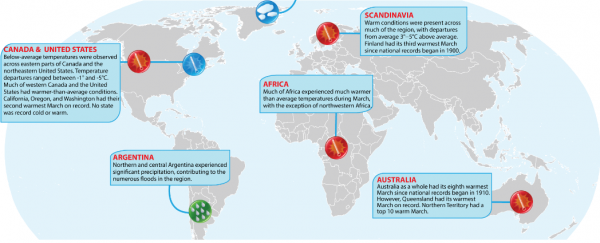Last month was the hottest March on record, and is one of a string of months this year that have already broken heat records as part of an ominous new trend, a new report by the the National Oceanic and Atmospheric Administration (NOAA) has revealed.
During March, the average temperature across global land and ocean surfaces ended up being 0.85 Celsius (1.53 Fahrenheit), says the report, which makes it the highest for March since 1800, when records first started being written down. This beats the previous record of 2010 by 0.05 C (0.09 F).
On top of that, the Northern Hemisphere had its second highest March temperature on record, according to the report, which is only behind 2008 in terms of temperature. And the Southern hemisphere tied with 2002 for third highest.
The report, which you can access here, continues:
"The March 2015 global temperature was the third highest monthly departure from average on record for any month, just 0.01°C (0.02°F) lower than the monthly anomalies for February 1998 and January 2007. This also replaces February 2015 (+0.84°C / +1.51°F) as the third highest departure from average among all months, moving that month to fourth highest.
Seven of the past eleven months (May, June, August, September, October, and December 2014, along with March 2015) have tied or set new record high monthly temperatures."
It's only a quarter of the year, and there's no telling what the rest of 2015 will end up like, but with El Niño in full swing, scientists are predicting it to get hotter rather than cooler. "2015 may be poised to eclipse 2014's newly minted record, though climate scientists are cautious on such pronouncements," Andrea Thompson says at Climate Central.
"We expect that we are going to get more warm years, and just as with 2014, records will be broken increasingly in the future. But perhaps not every year," said Gavin Schmidt, who leads NASA's Goddard Institute of Space Studies, told her.
The NOAA has put together a handy map to illustrate what's been going on, which you can see below. The red zones mark where weather has been warmer than the recorded average, and the blue zones are where it's been cooler than average. And click here for the full version of the map above.

Fortunately, the issue is actually starting to be treated with the importance it deserves. Yesterday in his weekly address, President Obama told the public, "Today, there's no greater threat to our planet than climate change. Climate change can no longer be denied or ignored." It will be interesting to see how far the US is willing to go to get things back on track in the future.
Sources: The NOAA, Climate Central
